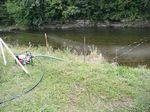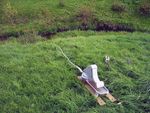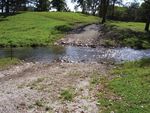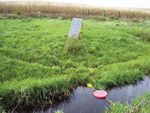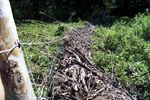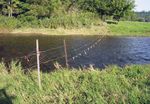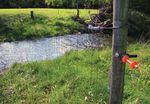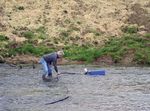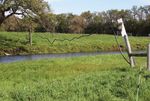MANAGING GRAZING IN STREAM CORRIDORS
←
→
Page content transcription
If your browser does not render page correctly, please read the page content below
MANAGING GRAZING IN
STREAM CORRIDORS
Prepared by the Minnesota Department of Agriculture
with funding from Section 319 “Nonpoint Source Management” of the Federal Clean Water Act
Howard Moechnig, Grasslands Specialist
Midwest Grasslands
37484 - 90th Avenue
Cannon Falls, Minnesota 55009
(507) 263-3149
mwgrasslands@frontiernet.net
November 2007
About the author:
Howard Moechnig graduated from North Dakota State University
in 1974 with a degree in Agriculture, majoring in Soil Science. He
worked for the Natural Resources Conservation Service from 1972
through 2006. For the last ten years of his career he was a Grazing
Specialist with NRCS, and was the State Grazing Specialist from
2001 through 2006.
After his retirement on Jan 3, 2007, Howard organized a consulting
business, Midwest Grasslands. His business specializes in consulting
with those who desire to manage their pastureland, rangelands, and
grasslands in a manner that will sustain the soil, water, and plant
resources. His work includes pasture and rangeland evaluation, and
planning managed rotational grazing systems on pastures, rangelands,
and land for wildlife habitat.
Howard has a small farm southeast of Cannon Falls where he raises
sheep and markets grassfed lamb. His pasture contains a stream
corridor nearly a half mile long and is used for grazing the flock.For additional information, contact the Minnesota Department of Agriculture at (651) 201-6012 or online at:
www.mda.state.mn.us
2.Table of Contents
Introduction . . . . . . . . . . . . . . . . . . . . . . . . . . . . . . . . . . . . . 4
Intent of the Publication . . . . . . . . . . . . . . . . . . . . . . . . . . . . . . 4
What are the Issues? . . . . . . . . . . . . . . . . . . . . . . . . . . . . . . . . 5
Permits . . . . . . . . . . . . . . . . . . . . . . . . . . . . . . . . . . . . . . . . 6
Management Options for Stream Corridors . . . . . . . . . . . . . . 7
Continuous Grazing Systems. . . . . . . . . . . . . . . . . . . . . . . . . . . 7
Managed Rotational Grazing Systems . . . . . . . . . . . . . . . . . . . . . 8
Abandonment of Grazing in Stream Corridors . . . . . . . . . . . . . . . . 9
Using Livestock to Improve Physical Characteristics of Streams . . . . . . 10
Factors to Consider in Plan Development . . . . . . . . . . . . . . . . 11
Stream Characteristics that Affect Plan Development . . . . . . . 12
The Size of the Stream . . . . . . . . . . . . . . . . . . . . . . . . . . . . . . . 12
Soils on the Streambank . . . . . . . . . . . . . . . . . . . . . . . . . . . . . . 12
Flooding . . . . . . . . . . . . . . . . . . . . . . . . . . . . . . . . . . . . . . . 13
Depth of the Stream Channel . . . . . . . . . . . . . . . . . . . . . . . . . . 13
Water Quality . . . . . . . . . . . . . . . . . . . . . . . . . . . . . . . . . . . 14
Vegetative Management in Stream Corridors . . . . . . . . . . . . . 15
Winter use of Stream Corridors . . . . . . . . . . . . . . . . . . . . . . . 15
Design and Layout of a Riparian Grazing System . . . . . . . . . . 16
Paddock Design and Layout . . . . . . . . . . . . . . . . . . . . . . . . . . 16
Fence to Include the Stream in Adjacent Paddocks . . . . . . . . . 16
Fence to Make the Stream Corridor a Separate Paddock . . . . . 18
Fence to Exclude the Stream Corridor . . . . . . . . . . . . . . . . . 19
Situations to Avoid . . . . . . . . . . . . . . . . . . . . . . . . . . . . . 19
Livestock Watering System . . . . . . . . . ......... . . . . . . . . 21
Source of Water . . . . . . . . . . . . . . . . . . ......... . . . . . . . . 21
Livestock Watering System Options . . . . . ......... . . . . . . . . 22
Stream Access Points . . . . . . . . . . . . .......... . . . . . . . . 22
Livestock Operated Pumps . . . . . . . . .......... . . . . . . . . 23
Sling Pumps . . . . . . . . . . . . . . . . . . .......... . . . . . . . . 24
Solar Pumps . . . . . . . . . . . . . . . . . . .......... . . . . . . . . 25
Engine Powered Pumps . . . . . . . . . . .......... . . . . . . . . 26
Hauling Water . . . . . . . . . . . . . . . ......... . . . . . . . . 26
Livestock Watering System Layout . . . . . . ......... . . . . . . . . 27
Fence System. . . . . . . . . . . . . . . . . . . . . . . . . . . . . . . . . . . . . 29
For More Information on Managed Rotational Grazing . . . . . . 31
3.Introduction
Intent of the Publication
Stream corridors are an integral part of many grazing systems in
southeastern Minnesota. Commonly, those areas within stream corridors
are used for pasture because of the high risk for crop damage due to
Major Land Resource Area 105 -
flooding and because there is a steady supply of water for livestock.
Northern Mississippi Valley Loess
The information in this publication is presented primarily for the region of Hills
southeast Minnesota, but it could easily apply to the entire region known
as the Driftless Area, Major Land Resource Area 105. In addition to
southeast Minnesota this area includes southwest Wisconsin and northeast
Iowa. This area has many cold water streams, those that are fed by
groundwater springs. Some of the concepts presented in this publication
apply to other parts of the country, but you must make adjustments when
applying them in areas that differ geologically.
The results of a recently completed EPA Section 319 project indicate
that there are significant positive environmental changes in streams when nrcs
livestock grazing in the riparian corridor is converted from a continuous
grazing form of management to that of managed rotational grazing. The
most beneficial changes include the change in the composition, health and
vigor of the plant community on the streambanks and adjacent area, as well
as the stabilization of the streambanks and subsequent improvement in the
physical structure of the stream channel itself.
Cattle doing final fall grazing on well managed streamside paddock.
This publication is intended to provide practical information for farmers
who manage livestock in pastures that contain flowing water riparian areas.
The information will help with planning a successful shift from continuous
4.grazing to one of managed rotational grazing. It includes planning criteria,
options, and situations to avoid. Much of this information is based upon
the experience of the author in planning grazing systems in riparian areas
in southeast Minnesota.
What are the Issues?
dave anderson, on the fly guide service
Trout fishing is a significant part of the tourist industry in Southeast Minnesota.
Considerable effort has been expended in recent years to improve treatment
of stream riparian corridors to reduce erosion of the streambanks, to
reduce introduction of pollutants into streams, and to improve streams as
resources for fish production and reproduction. Many reaches of streams
in southeast Minnesota have been monitored and the results indicate
loadings of sediment, nutrients, and bacteria in excess of state standards for
water quality. Efforts to remediate pollutant loading include improving the
management of the land in the watersheds of the impacted streams.
Because the pastures in riparian areas make up a small percentage of the
land use in most watersheds, the impact on overall water quality for the
stream may not be significant when accounted for on its own. However,
significant improvements in grazing management on individual reaches
of streams can have a positive impact on the health of the environment
by reducing the erosion of the streambanks and by reducing the time that
livestock actually spend in the water. The benefits to the livestock producer
include better forage production, improved livestock health, and improved
stream condition.
In addition to reducing pollutant loading, there is considerable interest
in improving the streams for fisheries, especially for trout. Southeast
Minnesota contains many miles of cold water trout streams. Trout fishing
and related recreational activities such as camping are important to the
economy of the region.
5.Livestock grazing in stream corridors is a definite asset to riparian
management, when properly managed. Removing livestock from a stream
corridor may be detrimental to the overall health of the riparian system.
The emphasis is, of course, on properly managing the grazing activity of the
livestock in time with the stage of growth of the plants in the riparian zone.
Permits
Prior to doing any construction activity in a stream that will alter the course,
current, or cross section of the channel, it is advisable to notify the Minnesota
Department of Natural Resources (DNR) to verify whether or not a permit for
the work is required.
6.Management Options for Stream Corridors
Continuous Grazing Systems
Common grazing management of pastures, including those that contain
streams, has been to allow livestock to graze the entire pasture from the
beginning of the grazing season to the end of it. This is continuous grazing.
The effects of this type of management are detrimental to the health of the
stream and its adjacent riparian area. These effects include:
• poor health and vigor of the plant community on the streambanks;
• erosion of the streambanks resulting from livestock grazing and
watering actions on the streambanks;
• very little diversity of the plant community;
• short vegetation provides no cover and shade for the stream itself;
• increased water temperature because of lack of shade;
• direct deposition of manure and urine in the stream by the
livestock as they gather, rest, and ruminate while standing in the
stream;
• loss of beneficial physical structure of the streambanks that
provides cover for fish; and
• low overall yield of the forages in the pasture, reducing livestock
performance.
Cattle grazing a stream corridor in
a continuous grazing system. The
livestock have access to any part of
this stream through the entire grazing
season.
nrcs
7.Managed Rotational Grazing Systems
Managed rotational grazing is becoming more accepted as an improved
method of managing pastures, including those that contain stream
corridors. In this type of management, livestock are placed in one portion
(a paddock) of the pasture (divided into several paddocks) when the
forages are ready for grazing. The livestock are systematically moved from
one paddock to another based on the stage of growth of the forages and on
the objectives for the grazing system as well as for each paddock. With this
system of management the forages have an opportunity to rest and recover.
This maintains them in a healthy and vigorous condition. The amount of
time that livestock have access to any segment of the stream is significantly
reduced with managed rotational grazing.
The effects of this method of managing streamside pastures include:
• streambanks become covered with growing vegetation;
• a more healthy, vigorous, and diverse plant community;
• reduced erosion of streambanks;
• reduced warming effect on the water
because of shading by healthier and taller
plants;
• reduced amounts of manure and urine
deposited directly into the water because
livestock spend less time in the water;
• improved structure of the stream that
provides concealment for fish; and
• improved productivity of the forages in
the pasture, providing improved livestock
performance. Stream cross section with managed
rotational grazing.
Cattle grazing a streamside paddock.
They have access for a short period
of time and are not allowed to return
until the plants recover from the
grazing, normally 30 days.
8.Abandonment of Grazing in Stream
Corridors
Removal of livestock grazing from stream corridors is
commonly recommended but not necessarily a good option
for management of the stream corridor. When grazing is
terminated, the stream is subjected to changes because of
the shift in the composition of the plant community.
• Early in this progression, the grasses become
much more healthy and vigorous because of the
lack of animals removing plant top growth. This
is especially true in situations where the grazing
management was “continuous grazing” prior to
abandonment of grazing.
• Over a period of a few years, the plant community
Abandoned pasture growing to weeds soon to be will shift to more tall, broadleaf herbaceous
dominated by trees and brush. plants, such as wild parsnip, burdock, and stinging
nettle. In addition, early successional woody
species, primarily boxelder and willow, will become
established. Under a grazing regime these would be
consumed by the livestock, or the plants would not
have been able to withstand the livestock traffic and
compaction.
• As the boxelder become more numerous, increase
in size, and provide a major portion of the canopy
that shades the ground, the grasses diminish and
eventually disappear. This leaves the woody species
and some shade tolerant, broadleaf herbaceous
plants on the streambanks and in the riparian
corridor.
Streams grown up to trees display wide, shallow cross
sections and eroding verticle banks. • During this process of the elimination of the
grasses, the stream channel itself changes. The
grasses that occupied sloping streambanks had an
extensive and fine root system that could, in most
cases, effectively prevent erosion. The herbaceous
broadleaf plants and woody species that replace
the grasses do not have root systems that are
effective for protecting the streambanks. Erosion
of the banks occurs; the banks become vertical and
unprotected by vegetative cover and the stream
channel becomes wider and shallower. The stream
channel also is impacted by sediments so the value
for fisheries is significantly reduced.
9.Exclusion of livestock from streams in the area of southeast Minnesota,
and in many other settings, does not always result in better stream
conditions for fisheries and wildlife, nor does it always prevent negative
impacts to the environment. Livestock grazing and animal impact are tools
to be used as needed to maintain healthy streams and riparian corridors.
Without these tools, management options for stream corridor maintenance
are seriously restricted.
Sketch of stream cross section wooded
corridor.
Using Livestock to Improve Physical
Characteristics of Streams
When livestock graze adjacent to streams and on streambanks their hoof
action causes displacement of the soil in a way that reduces the slope of
the banks. This allows vegetation to establish, it reduces the width of the
stream, increases the depth and velocity of stream base flows.
Streams that have been damaged from overgrazing can be rejuvenated
by implementation of a managed rotational grazing system for the entire
pasture, and by implementing a system of controlled grazing on the
streamside paddocks. This stream grazing system will initially call for
high density grazing of livestock (many animals on a small area) on small
sections of the stream. Even vertical stream banks can be “gentled down”
by the livestock. In the initial stages of the stream rejuvenation the stream
paddocks may need fairly long rest periods to allow for establishment of
new plants and recovery of existing vegetation after the grazing event. As
the stream shows improvement, rotational grazing may be done on a more
regular basis. You need to realize that monitoring the streamside paddocks
is very important so that proper grazing decisions can be made.
Streams that are degraded from overgrowth by trees and brush can be
rejuvenated in a similar way. However, some trees may need to be removed
mechanically to allow sunlight to reach the soil surface to promote the
growth of grasses. In some cases it is wise to spread some seed on the area
so that ground cover is established quickly.
10.Factors to Consider in Plan Development
Installation of a managed rotational grazing system in stream corridors will
provide considerably more forage than a continuous grazing system, while
protecting the stream channel and adjacent riparian areas from detrimental
impacts of grazing livestock. This conversion requires a significant change
in management of the pastures. Plans for the managed rotational grazing
system must include:
• well thought out objectives, especially related to what the stream
will look like when the plan is fully implemented;
• management strategies for the forages;
• a system of fencing;
• stream crossings;
• a system of providing water for the livestock;
• provisions for easy movement of livestock; and
• access requirements for machinery.
11.Stream Characteristics that Affect Plan Development
The Size of the Stream Several factors related
Large streams are much more difficult to deal with in grazing systems than to the stream itself, the
smaller streams. Fences are more difficult to install. Livestock crossings soils, and the vegetative
are more difficult. Crossing large streams with pipelines for water is more resources in the adjacent
difficult. It is generally easier to have a beneficial impact on streams that riparian area must be
are smaller in size.
considered in order
to design a grazing
Soils on the Streambank system that will meet
Streambanks with soils that are finer textured are generally easier to stabilize the objectives of the
with grazing than those composed of sand and gravel. Finer textured soils landowner while keeping
will endure livestock traffic quite well. They are more fertile and generally the stream corridor in a
have a more viable seed bank from which new plants will emerge.
healthy condition.
Small streams are generally easier to
manage for grazing.
mda
Large streams present greater
challenges for grazing management
than smaller streams.
mda 12.Sandy and gravelly soils will not stand up well to livestock traffic. Livestock
traffic will displace and damage plants. The droughty nature and low
inherent fertility levels of these soils hinder the growth of new vegetation.
These soils are easily eroded from the banks of streams, making the banks
very difficult to stabilize.
Flooding
Flooding is one of the most significant factors affecting grazing plans and
designs. Flooding can easily take out fences and livestock watering system
components. In addition, the quality of the floodwaters may be detrimental
to livestock as a water source. Sediment deposition and excess wetness can
delay re-entry to streamside paddocks by livestock.
nrcs
Flooding presents issues with fence
and water pipeline crossings.
Flooding is more difficult to deal with the more frequent the flooding is,
the deeper and wider the floodwaters are, the faster they flow, and the
longer the area stays flooded.
Depth of the Stream Channel
Streams that are deeply incised into the surrounding landscape are more
difficult for livestock to traverse. This makes it difficult to provide the
kind of impact necessary to reduce the slope of the banks to a point where
vegetation can get established. In addition, livestock may have difficulty in
getting to the water if the stream is used as the primary water source.
Some streams are so deeply incised that it is not feasible for livestock to
have access to the banks. Heavy equipment is sometimes used to reduce
the slope of the banks prior to seeding the banks to establish vegetation
before the introduction of livestock.
13.Water Quality
The quality of the water in the stream will determine how much access is
provided to livestock, or if the stream is even a satisfactory source of water.
Excess levels of sediment, pathogens, nutrients, or pesticides will adversely
affect livestock performance and herd health. Streams with good quality
water are normally economical sources of livestock water.
During times of flooding, or even during runoff events, water can carry
high concentrations of pollutants. In many of the streams in southeast
Minnesota, these runoff events are short term and the water clears up rather
quickly. During periods of runoff it may be best to not use the stream as a
source of drinking water.
14.Vegetative Management in Stream Corridors
The primary purposes for preparing a managed rotational grazing plan for
pastures containing stream corridors are to manage the plant community Each situation needs to
for optimum health and vigor, to develop an erosion resistant root system, be based upon the desired
to provide shade for the water for temperature control, to provide habitat
for fish and wildlife, to control livestock use of the stream, and to provide effect on the vegetation in
forage for grazing livestock. the paddock. By noting
A healthy stream corridor will contain a plant community composed of the effects grazing has on
diverse species, mostly grasses, but with some trees and patches of brush
the vegetation, you can
scattered throughout. The plants will be used for grazing but will recover
quickly because they will not suffer from overuse. learn what the impacts of
The most useful method of determining when livestock should be moved the livestock are and be
from the corridor is to measure the residual stubble height. In general, better able to predict those
when livestock have grazed the plants to a residual stubble height of four
inches, it is time to move them to another paddock. effects in various situations.
This can vary, however, by what is desired for vegetation. For example, if Monitoring is the essence
you want livestock to suppress the growth of brush, you may have to keep of good vegetation
them in the paddock for a longer time and the decision to move them will
be based upon the effects they have had on the brush. In this case, if they management.
are kept in a paddock longer than normal and they have grazed the grass
much more than desired in order to impact the brush, then this paddock
would receive a longer than normal rest period so that the herbaceous
vegetation can recover from the livestock impact.
Winter use of Stream Corridors
Stream corridors should not be used as outwintering sites, where livestock are kept and fed throughout
the winter months. When used as such there is a substantial threat to water quality in the stream from the
deposition of manure and urine on the frozen ground in the stream corridor. When the weather warms and
melting takes place, the runoff will carry significant amounts of nutrients into the water of the stream.
This does not mean that the stream cannot be used as a source of drinking water for livestock that are
outwintered in paddocks situated a distance from the stream. It is feasible and practical to have livestock travel
in a lane to the stream for water. If a permanently placed lane is not available to provide a path for the livestock,
then a lane constructed of temporary fencing materials should be used to guide the movement of the livestock.
The watering site at the stream should be a constructed access point. In this type of situation, livestock will
travel to the stream for water and then back to the outwintering site for feed. They do not loiter in the stream,
so deposition of manure and urine in the stream corridor is dramatically reduced as opposed to situations
where livestock are wintered in the stream corridor itself.
15.Design and Layout of a Riparian Grazing System
Paddock Design and Layout
Three options are commonly used to manage the impact of livestock on
stream corridors. Each option is based on stream characteristics and on the
characteristics of the adjacent pasture. Within each of these options there
can be some variation. Each site needs to be evaluated on the basis on its
specific characteristics.
fence to include the stream in adjacent
paddocks
With this option the stream is included in the paddocks that it flows
through. Livestock have full access to the stream for the grazing period
for that paddock. In these systems, the stream normally serves as a source
of drinking water for the livestock. Constructed access points are a good
option in this system as a way of reducing livestock impact on streambanks.
It can be seen from the accompanying sketch that this option calls for
the fences to cross the stream in several places, which can be problematic
during flood events. For this reason, this type of layout should be
considered for small order streams, on streams where flooding rarely
occurs, or on streams where flood waters are at slow velocities and do not
disrupt the integrity of the fences.
Sketch of plan with stream included in paddocks.
x x x
x
x
x
x
x
x
x
x
x
x This layout is
x recommended in
x
x situations where
x the stream is not
x
x
deeply incised into the
terrain. It is important
x
x for livestock to be able to
easily cross the stream in
x
this type of layout.
16.x x x
x x
x
Alternative method of laying out x
paddocks when including stream in
adjacent paddocks.
x
x
x x
x x
x
An option to having significant portions of the paddock on both sides of
the stream is to fence in a manner that includes the stream on one end of
the paddock. Livestock are unlikely to cross the stream for a small sliver
of pasture on the opposite bank, allowing the vegetation to grow with
little grazing pressure. This can provide low livestock impact to areas of
streambanks that need additional rest or time to recover from livestock
impact.
As you monitor the streambank it will become apparent where livestock
impact should be increased or decreased to benefit the stream and the plant
community. It is desirable to install the fences in a way that allows easy
management of livestock movement to areas that need increased livestock
impact, or to keep livestock away from areas that need additional rest.
This can be accomplished by installing easily moved temporary fences or
constructing gates at strategic points in the fences to allow easy livestock
movement.
17.fence to make the stream corridor a
separate paddock
A second option is to fence the stream corridor in a manner that makes
the corridor a paddock apart from the other paddocks in the pasture. This
is a very good option when the stream is a larger order stream than those
discussed above. In cases where flooding frequency, duration, and intensity
are such that fences would be very difficult to maintain, this is a reasonable
approach. Only two permanent fences that cross the stream are necessary:
one at the upstream end of the corridor and one at the downstream end of
the corridor. This reduces the maintenance workload for fences.
x x x x x
x x x
x x
x x x
x
x
Sketch of a plan with stream fenced as
x x
x x x a separate corridor.
x
x
x x
x x
x
x x x
x
x
This is also a good option when the stream corridor needs to be managed
closely to obtain the desired effect. Examples of this type of situation
include streams that are important fisheries and corridors that contain
features that are quite sensitive, such as significant streamside wetlands or
streambanks with soils that are easily damaged by grazing.
These stream corridor paddocks can be, and in most cases need to be, split
into several smaller paddocks (depending upon the size of the corridor
paddock and the livestock density) to adequately apply proper grazing
pressure and to obtain the desired effect on the vegetation and stream itself.
Temporary fences made from polytape or polywire and using step-in posts
are commonly used in these situations so they can be rolled up when not in
use. The only fences that are exposed to the effects of floods are the fences
at each end of the stream corridor paddock.
18.Stream crossings are necessary where the substrate in the stream bottom is
not solid enough to support livestock traffic or where the stream is incised
deeply into the landscape and the livestock have difficulty traversing the
stream. These crossings may also serve as access points from which the
livestock can drink water.
With this option there needs to be some type of livestock watering system
installed to provide water to the paddocks that are outside of this fenced off
corridor. Refer to the section on livestock watering systems for guidance.
A stream corridor paddock can serve as a “manifold” through which
livestock may be moved from one paddock to another, minimizing or
eliminating the need for travel lanes.
fence to exclude the stream corridor
In some cases it is in the best interest of the stream to totally exclude
livestock. This is pertinent in the following situations:
• The stream is so deeply incised into the landscape that livestock
grazing on the stream banks or watering from the stream cause
serious trailing and erosion issues.
• The soils of the streambanks are sand and gravel, and any livestock
traffic will damage the soils and vegetation. In these soil conditions
the vegetation easily suffers serious damage and cannot recover
adequately enough or quickly enough to stabilize the streambanks
to protect them from erosion.
• In the case of pastures adjacent to very large streams or rivers, it is
sometimes best to exclude the livestock. This is especially true if
the stream floods often or if the banks of the stream are seriously
eroding. High vertical banks along major streams are difficult to
positively impact with livestock grazing.
situations to avoid
There are some situations that should be avoided when setting up paddocks
in pastures with streams. These situations can cause livestock trailing
which leads to erosion, and zone grazing. Zone grazing is overutilization
of forages in portions of the pasture closest to water and underutilization
of forages that are farther from the drinking water.
The first of these situations is installing travel lanes close to and parallel to
streams. Due to livestock traffic the vegetation in the lane is damaged and
significant bare soil areas exist. In addition, significant amounts of feces
and urine are normally deposited in lanes. The result is degradation of
the water quality from erosion of the soil and movement of nutrients and
pathogens to the stream.
19.Sketch of situation to avoid - lane
constructed adjacent to stream.
a ne
lL
x
v e
Tra x
x
x
x x
x
x x x x
A second situation is pastures with a stream in one corner, along one side,
or only in a small portion of the overall pasture. It is tempting to fence
portions of the stream into each paddock, having the paddock stretch
out into the pasture for long distances. Livestock tend to ruminate and
rest in areas near the water and do not travel long distances from it. It is
generally accepted that cattle will do uniform grazing up to a distance of
800 feet. Beyond that distance forage utilization diminishes and “zone
grazing” is evident. To overcome this, paddocks should be sized to match
the production of the forages, the desired grazing period, and the projected
forage requirement of the herd. Paddocks should be planned and installed
to use the stream for water to the extent possible, with the above distance
criteria in mind. Those paddocks that do not have access to the stream
should be set up with a functional livestock watering system, as explained
in the section “Livestock Watering System.”
x x x
x
x
x
800
x
Sketch of situation to avoid - paddocks
Ft.
with too much travel distance to water.
x
x
x
x
x
x
x x
20.Livestock Watering System
One of the benefits of having a stream in a pasture is that it provides a
The goals for a well planned convenient and economical source of water for livestock. On the other
livestock watering system hand, streams can carry pollutants that will adversely affect livestock
performance and may even lead to herd health problems.
include the following:
You must consider the land use and treatment in the watershed that
• To provide water to the area provides runoff to the stream and be able to plan around runoff events.
The more common pollutants of concern are sediment, nutrients,
where livestock are located. pesticides, and pathogens. With most cold water streams in southeast
This prevents their trailing Minnesota, the runoff from storms passes through very quickly, usually
within two days. After that, the water quality returns to the same
to a watering point or facility conditions that were present prior to the runoff event. Streams with
and reduces the erosion from serious and continuous water quality issues should be avoided as a source
of water for livestock.
trailing.
Even a stream that appears to be clean may have issues related to
pathogens. It is important to monitor the health of the herd so that
• To be able to closely
changes to management can be made before serious damage occurs to the
manage livestock impact livestock.
on vegetation and physical Providing water from a stagnant source (dugouts or constructed earthen
structure of streambanks and dams) is a relatively poor method of watering livestock. These are
unreliable sources of water during periods of drought. In addition, the
channel. quality of the water is usually much poorer than that from flowing streams.
• To reduce the deposition of Many times a stream is no longer directly available for water for livestock
when a pasture is subdivided into paddocks to control grazing in the
feces and urine directly into riparian areas. This requires installation of a watering system so that
the water, thus improving livestock have access to water in all of the paddocks without having to
travel long distances to a central watering point.
water quality.
Source of Water
The source of water provided to paddocks can be either the stream itself
or water brought to paddocks from another source, generally through
pipelines. Which source to use depends upon the distances to convey
the water, the terrain (especially elevation differences), and the quality of
the water in the stream. Cost of installation, flow characteristics of the
stream (especially flooding issues), and maintenance requirements of the
equipment are additional factors.
Wells at farmsteads generally provide the best quality drinking water.
A livestock watering system connected to a farmstead water system is
normally the most dependable method of providing good quality water to
livestock on pastures. Water can be piped for long distances unless it needs
to be pumped up significant elevations.
21.Livestock Watering System Options
stream access points
The easiest and most economical method of providing water to livestock
in pastures adjacent to or including streams is to provide stream access
points for the livestock. The locations of these should coincide with areas
that are currently being used by the livestock. This does not disrupt their
established habits, and they are usually using those places that are easiest
to develop. In most cases, the access points that livestock are already using
need to be upgraded with shaping and placement of a stable surface for
livestock to stand on.
Stream access points are relatively easy
to construct and maintain. They can
serve as stream crossings.
Improved stream crossings can serve as access points for watering, but a
barrier, such as a strand of electric fence, may be required to keep livestock
on the side of the stream that you want them on.
22.livestock operated pumps
Livestock operated pumps are many times referred to as “pasture pumps”
or “nose pumps.” These pumps are actuated by the livestock pushing the
pump arm with their noses to pump the water from the source. The typical
source is a pool of water in the stream. The inlet to the pump is suspended
in the water to prevent it from sucking in mud. A one-way check valve is
installed at the inlet so that the water in the pipeline feeding the pump does
not have a way to return to the stream, thus keeping the pump primed.
Livestock operated pump. This one
was set up for demonstration. In
reality they need to be anchored to the
ground so livestock do not push them
around.
These pumps work quite well, but keep the following in mind:
• They can handle approximately 30 cows per pump, so you may
need more than one available to each paddock if your herd is larger
than that.
• They are portable. It is a good idea to leave the inlets in place and
move the pump to other established inlets to save time in setting
them up.
• You must prime the pump initially for the livestock.
• Small animals, such as calves or sheep, will not be able to operate
the pump. In cow/calf operations, a small pan is sometimes
installed under the pump to catch overflow for the calves.
• The pump is limited to a distance of 150 feet from the water
source. It will lift water about 26 feet, but only if placed close to
the source of water. It is more difficult to operate as it has to lift
water higher.
• It requires no electricity to operate.
23.sling pumps
Sling pumps float in a stream and the movement of the current on the
blades causes the blades to spin. The pump picks up water from the stream
and moves it through internal tubes to the pump outlet through a hose to
a watering facility. These pumps come in various sizes. The smallest one
can pump 550 to 830 gallons per day depending upon the velocity of the
stream.
Sling pump operating in stream.
Keep the following items in mind if considering this pump:
• The pump takes a fair-sized stream to operate in. If the pump
touches the side or bottom of the channel it will quit pumping.
The smallest pump on the market takes a stream that is at least
one foot deep with adequate velocity.
• The pump must be anchored well to keep it in place.
• These pumps are subject to curious passers-by if located on a
stream used for fishing or canoeing.
• They can be easily disrupted and damaged by high water flows.
• The water tank that it pumps to must have an overflow so excess
water can be removed from the area to prevent formation of
mudholes. There is no way to put a system on the pump to stop
flows when the tank is full.
24.solar pumps
Solar pumps come in a variety of configurations. One common type is
directly connected to a solar panel. It operates all the time when the sun
is shining. Another type is actually a battery operated pump connected so
that the solar panels charge the batteries. This type can be easily regulated
to turn on and off as water use dictates.
One type of solar pumping system.
This one pumps whenever the sun
shines on the solar panel. It is set up in
a paddock adjacent to the one with the
livestock to avoid livestock damage to
the solar panel. It pumps to a tank in
the paddock with the livestock.
Important considerations for solar pumps include:
• They may be expensive, although the cost varies considerably
depending on the basic design.
• They require a three day water supply in reserve unless battery
powered.
• They can draw water from open water sources or wells.
• They can be used to power a pressurized system to push water for
long distances.
25.engine powered pumps
Engine powered pumps are capable of pumping large volumes of water for
long distances and more than 100 feet of elevation. The cost is generally
reasonable.
Engine powered pumps are a
good option when electricity is not
available.
Important considerations for engine powered pumps include:
• You must protect them from flood waters.
• The machine pumps water until it is shut down or it runs out of
fuel. Some operators know about how long they want the pump to
run and put a small amount of gasoline in the tank and let it pump
until it runs out of fuel. Some overflow of the tank may occur and
should be directed away from the tank.
In all cases with watering systems that pump from flowing streams, it is
important to flood-proof the installation as much as possible. Many of
the options described above will suffer serious damage during floods. All
systems require some maintenance. They cannot be put into place and
expected to operate without any attention.
The positive aspect of these systems is that they will provide water in
locations where electricity is not available or where water cannot be
pumped or hauled. In this respect, they are well worth considering.
hauling water
This is a practical way to meet the needs of livestock in smaller herds and in
situations where the cost of other methods is excessive for the benefit.
26.Livestock Watering System Layout
The placement of pumps is restricted, to a large degree, by the kind of
pump chosen and the source of water. Pumps can draw water for only
relatively short distances, but some can push the water for very long
distances.
Livestock powered pumps, sling pumps, and some solar/battery powered
pumps are useful for pulling water from a stream for use in paddocks
adjacent to the stream. Livestock water access points are only useful for the
paddocks in which they are located, unless a lane is provided for livestock to
travel to the access point from more distant paddocks.
Gasoline powered pumps and more powerful solar/battery powered pumps
can draw water from streams and transport it long distances to watering
facilities in paddocks that are not adjacent to the stream. These systems
allow for subdivision of the pasture in a manner that does not require each
paddock to contain a section of the stream. You can install a better grazing
system in this case that will reduce the incidence of zone grazing and will
reduce trailing for water over relatively long distances.
In some cases it is advisable to extend a pipeline system from a well, typically
at the farmstead, to watering facilities in the paddocks. This should be
your first option if it is possible, since a pipeline generally requires less
maintenance and is more reliable. The cost of this must be weighed against
the cost of alternative pumps, the cost of their installation, and the amount
of maintenance expected in a season of use.
Water tanks placed a distance from
the stream.
x x x x x x
x
x
Tank
Tank
Tank
x x x x x x
x x x
27.If livestock are placing excess pressure on a stream, causing damage to the
soils, vegetation, and water quality, a simple solution may be to place a
water tank in the streamside paddock at some distance from the stream. It
has been demonstrated that livestock will water from the tank more often
than from the stream, especially if direct access to the stream is difficult.
Most livestock would prefer to drink from still water and prefer warmer
water to the cold water from spring-fed streams.
Major drawbacks to having livestock travel long distances to water, even
in travel lanes, is that they tend to deposit a significant amount of their
manure in the lane that leads to and from the watering facility, and that
they tend to lounge in the area of the watering facility. These issues defeat
two major advantages of managed rotational grazing systems: keeping
the livestock on the desired paddock so that they consume forages, and
spreading the fertility (in the form of feces and urine) through the entire
pasture rather than at lounging areas and watering points.
Crossing streams with pipelines can be difficult. The larger the stream, the
more difficult it is. The major consideration is to keep the pipeline in place
during flood events. The recommended method is to shallow bury the
pipeline through the floodplain, bringing the pipeline out of the ground
at the stream and elevating it above the water by hanging it on an elevated
pole or cable strung across the stream. When preparing a grazing plan
that includes stream corridors, it is advisable to cross the stream in as few
locations as possible.
This illustrates one method for
crossing a stream with a water
pipeline.
The major issues with fences in stream corridors are protecting the fences
from floods and constructing fences across the stream that will contain the
livestock even during periods of normal and low flows.
28.Fence System
Flooding easily causes damage to
fences.
You can minimize flood damage to fences by minimizing the number
of crossings needed, especially for permanent fences. This is done by
planning the grazing system so that the stream corridor is a single paddock
that can be subdivided using temporary fences. In this system the only
permanent fence crossings are at the upstream and downstream ends of
the stream corridor.
Construct fences that use fewer strands of wire in floodplains that are
subject to flows that will damage them. For example, a single strand
electrified fence will catch less debris than one with four wires, reducing
the maintenance requirements.
29.Another strategy is to construct the fence sections that are prone to
damage by floods in a manner that will allow them to “break away” from
the rest of the fence. This will minimize the damage.
The fence in this photo is clearly
marked for canoeists and has “break-
aways” to allow one end of the wire to
unhook during floods.
For electrified fence, a good method of “closing” the opening where it
crosses a stream is to string one electrified wire across the channel and
install wires or chains that hang from it to a point close to the water
surface. This will provide a deterrent to livestock that may want to walk in
the stream channel to escape from the pasture.
One method of keeping livestock from
going past a fence that crosses a stream
channel.
For barbed wire fences, the same type of system may be used, but you need
to add some weight to the wires to keep tension on them so that it appears
to the animals that they cannot move beyond them.
Plan the fence system to allow for easy movement of livestock from one
paddock to any other in the pasture. This reduces stress on the animals
when they are being moved and it allows for easier management of the
entire system.
30.For More Information on Managed Rotational Grazing
Additional sources of information are available to help plan and manage
managed rotational grazing systems. These include:
Grazing Systems Planning Guide by Kevin Blanchet, Howard Moechnig,
and Jodi DeJong-Hughes. Revised 2003. Extension Distribution Center,
405 Coffey Hall, 1420 Eckles Avenue, St. Paul, MN 55108. Phone:
(800) 876-8636. Website: www.extension.umn.edu Listed as publication
BU-07606-S.
Understanding Grass Growth: The Key to Profitable Livestock Production by
Steven S. Waller, Lowell E. Moser, and Patrick E. Reece. 1985. Trabon
Printing Co., Inc., 430 East Bannister Road, Kansas City, MO 64131.
Phone: (816) 361-6270. Website: www.trabon-paris.com
Pastures for Profit: A Guide to Rotational Grazing by Dan Undersander,
Beth Albert, Dennis Cosgrove, Dennis Johnson, and Paul Peterson.
Revised 2002. Cooperative Extension Publications, 432 North Lake
Street, Rm 103, Madison, WI 53706. Phone: (877) 947-7827. Website:
learningstore.uwex.edu/pdfA3529.pdf Listed as publication A3529.
Minnesota Department of Agriculture Grazing Specialist:
Wayne Monsen, 625 Robert Street North, St. Paul, MN 55155.
Phone: (651) 201-6260. E-mail: wayne.monsen@state.mn.us
Root River Watershed Grazing Specialist:
Jeff Duchene, Fillmore Soil and Water Conservation District, 900
Washington Street NW, Preston, MN 55965.
Phone: (507) 765-3878 ext 128. E-mail: jeff.duchene@mn.nacdnet.net
USDA-Natural Resources Conservation Service Grazing Specialists:
John Zinn, State Grazing Specialist, Valhalla Center, 330 Elton Hills
Drive NW, Rochester, MN 55901. Phone: (507) 289-7454.
E-mail: john.zinn@mn.usda.gov
Lance Smith, Grazing Specialist, 800 East Main Street, Suite
400, Marshall, MN 56258. Phone: (507) 537-0541. E-mail:
lance.smith@mn.usda.gov
Mark Hayek, Grazing Specialist, 809 - 8th Street SE, Detroit Lakes, MN
56501. Phone: (218) 847-9392. E-mail: mark.hayek@mn.usda.gov
Private Grazing Consultant
Howard Moechnig, Grasslands Specialist, Midwest Grasslands, 37484
- 90th Avenue, Cannon Falls, MN 55009. Phone: (507) 263-3149.
E-mail: mwgrasslands@frontiernet.net.
31.32.
You can also read

